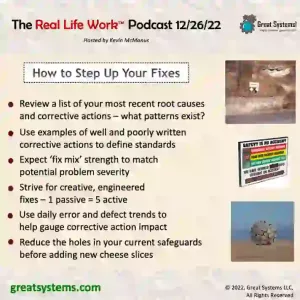This equipment reliability and asset health improvement podcast examines how to minimize operational costs and repeat failures.
Too many organizations continue to struggle to put a formal equipment reliability system in place. This episode of my ‘Real Life Work’ podcast looks at seven equipment reliability and asset health improvement tips I have picked up over the years.
An effective equipment reliability and asset health improvement process provides organizations with two key benefits. First, such a process helps minimize operational costs.
More importantly, it helps ensure that the company can deliver the products or services its customers desire. Equipment reliability is a hot topic.
Here is a quick summary of the seven tips I share in the podcast. Enjoy!
What does equipment reliability mean in your organization? Why is it important?
To many, it is no more than an equipment downtime reduction effort. However, equipment reliability improvement involves more than that. True, there are the twin goals of (1) downtime frequency and (2) downtime duration reduction.
Improvements in both areas lead to an increase in the mean time between failure (MTBF). Such gains help reduce process costs. Plus, these gains improve product / service quality.
Also, an effective equipment reliability process includes a focus on process output optimization while the process (equipment) is online. However, all three goals are lagging indicators that improve as asset health improves.
You can use indexes and trends to measure asset health across multiple performance areas, such pressure, speed, and temperature. Asset health indexes improve as a result of effective indicator monitoring, coupled with the implementation of improvement projects that address high risk failure areas.
Assess your own belief systems as a management team. Do you believe that people come to work with the desire to do a good job? Do you think people will cut corners any chance they get?
How often do you blame people when problems arise? Is it your tendency to search for those systemic factors that by design could encourage higher levels of human error?
Do you believe that equipment failures are simply a fact of life? Does your management team attempt to identify and remedy those system-induced human errors that lead to a higher frequency and severity of equipment problems?
People are much more reluctant to take asset ownership if they perceive they will be left out on an island. Does management help them succeed or set them up for failure?
DISCOVER MORE: Check out and subscribe to the Great Systems YouTube Channel

In this edition of the Real Life Work podcast, I share how work team leaders use the four steps to effective rule enforcement. Welcome...

My ‘Too Many Work Teams, Too Little Team Effectiveness’ Real Life Work podcast explores work team effectiveness and characteristics. Welcome to My ‘Too Many...

This post explores why our process improvement fixes fail. More importantly, it gives you key ways to help fix those problems. Why Our Process...